★★★
“Bring it On crashes head-first into Set It Off.”
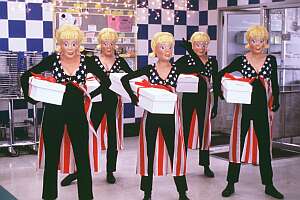 “Get ready to cheer for the bad girls,” goes the tag-line, and despite an exterior fluffier than candy-floss, the message here is actually extremely subversive: crime does pay. This sets it apart from most other crime-chick flicks, which almost inevitably end in death, destruction and more conventional morality. Guess being a comedy allows you a certain latitude in such things. Head cheerleader Diane (Shelton) gets pregnant courtesy of jock Jack (Marsden); finding it impossible to make ends meet, she takes inspiration from Point Break and convinces her friends to rob the bank where she works. But they’re witnessed by Lisa, a girl on the B-squad…
“Get ready to cheer for the bad girls,” goes the tag-line, and despite an exterior fluffier than candy-floss, the message here is actually extremely subversive: crime does pay. This sets it apart from most other crime-chick flicks, which almost inevitably end in death, destruction and more conventional morality. Guess being a comedy allows you a certain latitude in such things. Head cheerleader Diane (Shelton) gets pregnant courtesy of jock Jack (Marsden); finding it impossible to make ends meet, she takes inspiration from Point Break and convinces her friends to rob the bank where she works. But they’re witnessed by Lisa, a girl on the B-squad…
Written, produced and directed by women, this fully hits its stride only after the robbery. There’s one shot of the team walking down a school corridor in slo-mo, while their fellow pupils, fully aware of their exploits, scurry to get out of the way. Backed by Juno Reactor’s entirely appropriate Pistolero, it’s fabulous, and you wish they’d developed the post-crime scenario further, not least because the ending is extremely limp. Before the raid, it’s a hit-and-miss satire with some excellent jabs, but too much shallow emoting and hugging. Though award bonus points for casting Sean Young as a jailed mother, and the character quirks keep it from becoming too dull.
 Certainly not the best high-school studio satire ever (Heathers or Election), it’s likely the only one post-Columbine to feature semi-automatics, albeit in watered-down fashion. According to Mena Suvari, “It was really frustrating, because the movie we all signed on to do was very dark and very offensive, and while the finished movie is still that to a degree, it’s completely different.” One can only imagine what the original would have been like.
Certainly not the best high-school studio satire ever (Heathers or Election), it’s likely the only one post-Columbine to feature semi-automatics, albeit in watered-down fashion. According to Mena Suvari, “It was really frustrating, because the movie we all signed on to do was very dark and very offensive, and while the finished movie is still that to a degree, it’s completely different.” One can only imagine what the original would have been like.
Dir: Francine McDougall
Star: Marley Shelton, Mena Suvari, James Marsden, Rachel Blanchard





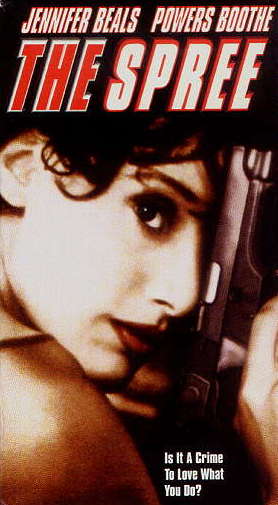 Good films about women burglars are hard to come by, for some reason. Mind you, good films about
Good films about women burglars are hard to come by, for some reason. Mind you, good films about 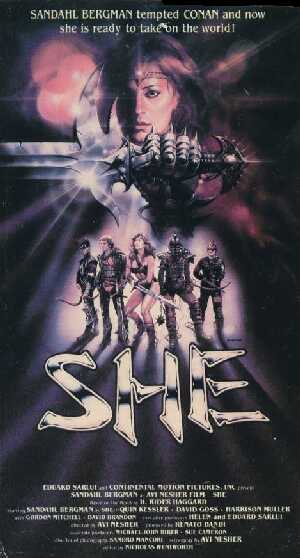 Proof positive that a lack of narrative coherence is no barrier to a good time, She makes about as much sense as you’d expect from a film where the soundtrack veers wildly from Rick Wakeman to Motorhead. It’s post-apocalyptic sword and sorcery, with Bergman as She, the immortal goddess ruling a tribe of Amazon warriors. For reasons which are never explained, She ends up tagging along with hero Tom as he searches for his kidnapped sister. Hey, even Immortal Goddesses need some time off, I guess.
Proof positive that a lack of narrative coherence is no barrier to a good time, She makes about as much sense as you’d expect from a film where the soundtrack veers wildly from Rick Wakeman to Motorhead. It’s post-apocalyptic sword and sorcery, with Bergman as She, the immortal goddess ruling a tribe of Amazon warriors. For reasons which are never explained, She ends up tagging along with hero Tom as he searches for his kidnapped sister. Hey, even Immortal Goddesses need some time off, I guess. One of the primary rules of exploitation cinema, is never to trust a movie with painted box-art. And, verily, no scene like the picture at right occurs in the film. Indeed, the whole film is sold on sizzle rather than steak, and will probably leave you feeling more than a little hungry. Verrell looks the part, though her slicked-back hair is rather too cliched and obvious, and she does appear to be doing her own action. Her lack of acting ability is painfully obvious, however, and Santiago is wise to keep her dialogue to a minimum.
One of the primary rules of exploitation cinema, is never to trust a movie with painted box-art. And, verily, no scene like the picture at right occurs in the film. Indeed, the whole film is sold on sizzle rather than steak, and will probably leave you feeling more than a little hungry. Verrell looks the part, though her slicked-back hair is rather too cliched and obvious, and she does appear to be doing her own action. Her lack of acting ability is painfully obvious, however, and Santiago is wise to keep her dialogue to a minimum.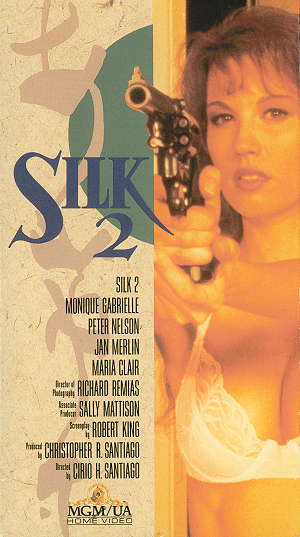 Was the world really crying out for a sequel? I guess Silk proved profitable enough for Gabrielle to replace Verrell as the titular cop, three years later and without any explanation. I’ve liked Gabrielle since her barnstorming double role in Deathstalker II, but even I have to admit she’s not really well-cast here, with her voice inappropriate for a supposedly tough crimefighter. Mind you, anyone would have problems with cliched aphorisms of the “Crime doesn’t pay” kind demanded by the dialogue.
Was the world really crying out for a sequel? I guess Silk proved profitable enough for Gabrielle to replace Verrell as the titular cop, three years later and without any explanation. I’ve liked Gabrielle since her barnstorming double role in Deathstalker II, but even I have to admit she’s not really well-cast here, with her voice inappropriate for a supposedly tough crimefighter. Mind you, anyone would have problems with cliched aphorisms of the “Crime doesn’t pay” kind demanded by the dialogue. Arriving on a DVD of such poor quality, it has been shorn entirely of both opening and closing credits, but hey, I paid $4.99, so can’t really complain. The heroine – named Charlene for most of the film – helps her father run the White Lotus, a rebel group fighting the government in 18th-century China. They have to avoid capture, while simultaneously looking for her long-lost mother (who is in her turn, looking after them), and further diversion is caused by a subplot involving an evil landlord trying to marry a young girl against her will.
Arriving on a DVD of such poor quality, it has been shorn entirely of both opening and closing credits, but hey, I paid $4.99, so can’t really complain. The heroine – named Charlene for most of the film – helps her father run the White Lotus, a rebel group fighting the government in 18th-century China. They have to avoid capture, while simultaneously looking for her long-lost mother (who is in her turn, looking after them), and further diversion is caused by a subplot involving an evil landlord trying to marry a young girl against her will.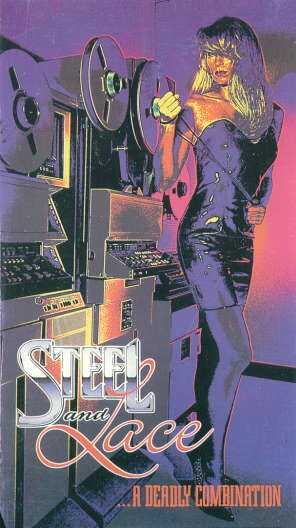 Inside ten minutes, we’ve had heroine Gaily Morton (Wren) raped and her attackers acquitted in court, not to mention her subsequent leap off a roof-top to her death – this isn’t a film which hangs around, boys and girls. Luckily, her brother is a NASA boffin (Davison – you might recognise him as the Senator from X-Men), who builds a robot in her image, in order to wreak gory revenge on the perpetrators five years later. Cleaning up behind are a cop (Naughton) and his ex-girlfriend, a courtroom artist (Haiduk) who joins the dots.
Inside ten minutes, we’ve had heroine Gaily Morton (Wren) raped and her attackers acquitted in court, not to mention her subsequent leap off a roof-top to her death – this isn’t a film which hangs around, boys and girls. Luckily, her brother is a NASA boffin (Davison – you might recognise him as the Senator from X-Men), who builds a robot in her image, in order to wreak gory revenge on the perpetrators five years later. Cleaning up behind are a cop (Naughton) and his ex-girlfriend, a courtroom artist (Haiduk) who joins the dots. This is an odd little film; heroine Angel (Walden – by some reports now a ski-lift attendant) is an assassin, ordered to take out the leaders of a white slavery ring. After the first killing, she finds solace in the arms of a random guy, and you
This is an odd little film; heroine Angel (Walden – by some reports now a ski-lift attendant) is an assassin, ordered to take out the leaders of a white slavery ring. After the first killing, she finds solace in the arms of a random guy, and you 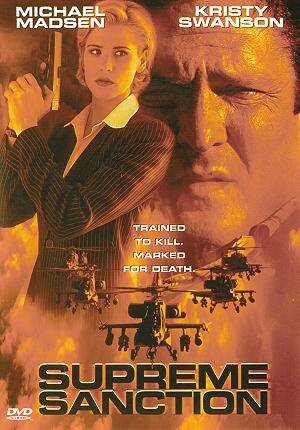 Director Terlesky starred in one of my favourite guilty pleasures, Deathstalker II, but this shows he still has much to learn about directing and, particularly, scripting. There just isn’t enough going on here to sustain attention, with too many scenes taking twice as long as necessary. Swanson plays Jenna, assassin for a government counter-terrorist agency which is now creating incidents in order to get increased funding. She switches sides and protects TV journalist Jordan McNamara (Dukes), whom she has been ordered to kill – her handler Dalton (Madsen) must now take her out.
Director Terlesky starred in one of my favourite guilty pleasures, Deathstalker II, but this shows he still has much to learn about directing and, particularly, scripting. There just isn’t enough going on here to sustain attention, with too many scenes taking twice as long as necessary. Swanson plays Jenna, assassin for a government counter-terrorist agency which is now creating incidents in order to get increased funding. She switches sides and protects TV journalist Jordan McNamara (Dukes), whom she has been ordered to kill – her handler Dalton (Madsen) must now take her out. The obvious point of comparison for Smith would be Pamela Anderson, another Playboy playmate who moved into films of doubtful quality, but any such comparison would be unfair. To Anderson, that is, who given the right role, is not actually too bad. With Smith, you get the feeling she simply has no talent, and any character would be a stretch, let alone the Shakespeare-aware, ace helicopter pilot and crackshot she is supposed to portray in this shameless Die Hard clone.
The obvious point of comparison for Smith would be Pamela Anderson, another Playboy playmate who moved into films of doubtful quality, but any such comparison would be unfair. To Anderson, that is, who given the right role, is not actually too bad. With Smith, you get the feeling she simply has no talent, and any character would be a stretch, let alone the Shakespeare-aware, ace helicopter pilot and crackshot she is supposed to portray in this shameless Die Hard clone.